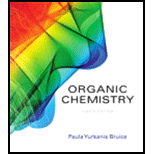
(a)
Interpretation: Two names of the given nitriles is to be written.
Concept introduction: The naming of nitriles can be done in two different ways:
First method is used to write the systematic name of these compounds. The systematic name of nitriles is written by adding the ‘nitrile’ in the suffix of parent name of
Second method is used to write the common name of these compounds. The common name of these compounds is written by replacing the “ic acid” of carboxylic acid by “nitrile”. These compounds also can be written as alkyl cyanides.
(b)
Interpretation:
Two names of the given nitriles is to be written.
Concept introduction:
The naming of nitriles can be done in two different ways:
First method is used to write the systematic name of these compounds. The systematic name of nitriles is written by adding the ‘nitrile’ in the suffix of parent name of alkane chain. The carbon atom of
Second method is used to write the common name of these compounds. The common name of these compounds is written by replacing the “ic acid” of carboxylic acid by “nitrile”. These compounds also can be written as alkyl cyanides.
Want to see the full answer?
Check out a sample textbook solution
Chapter 15 Solutions
Organic Chemistry; Organic Chemistry Study Guide A Format: Kit/package/shrinkwrap
- draw structure for: o-Hydroxy-1,4 benzenedioicacidarrow_forwardGive the IUPAC name for each of the fi ve constitutional isomers of molecular formula C 6H 14 in Problem 12.40.arrow_forwardDraw Haworth structures for the two possible isomers of D-altrose(Figure 7.2) and D-psicose (Figure 7.3).arrow_forward
- Draw the carbon containing products of the following reaction: Reactant = 2-bromo-2-methyloctane Reagent = CN minus, room temperaturearrow_forward39. Identify the type of the double bond given in each structure: E or Z type.arrow_forwardGive the structural formula and systematic name for the organic product, if any, from each of the following reactions: (a) pentanal and KMnO4 (b) 2-octanone and LiAlH4arrow_forward
- Rank the following groups in order of decreasing priority (1 = highest, 4 = lowest)arrow_forwardDraw the product of benzene and Cl2/FeCl3arrow_forwardRank the following molecules according to decreasing melting point where 1 is the highest melting point and 4 is the lowest based on IMF.arrow_forward
- Methanogenic bacteria convert acetic acid (CH3COOH) to CO2(g) and CH4(g). ΔH°f, (kJ/mol) ΔG°f, (kJ/mol) CH3COOH -484.5 -389.9 CO2(g) -393.5 -394.4 CH4(g) -74.8 -50.8 Calculate ΔH°rxn. ΔH°rxn = ____ kJ Calculate ΔG°rxn. ΔG°rxn = ___kJarrow_forwardGive both IUPAC names and common names for the following compounds. (d) HOOCCH2CH(CH3)CO2Harrow_forwardRank A-C in order of increasing melting pointarrow_forward
 General Chemistry - Standalone book (MindTap Cour...ChemistryISBN:9781305580343Author:Steven D. Gammon, Ebbing, Darrell Ebbing, Steven D., Darrell; Gammon, Darrell Ebbing; Steven D. Gammon, Darrell D.; Gammon, Ebbing; Steven D. Gammon; DarrellPublisher:Cengage Learning
General Chemistry - Standalone book (MindTap Cour...ChemistryISBN:9781305580343Author:Steven D. Gammon, Ebbing, Darrell Ebbing, Steven D., Darrell; Gammon, Darrell Ebbing; Steven D. Gammon, Darrell D.; Gammon, Ebbing; Steven D. Gammon; DarrellPublisher:Cengage Learning Introductory Chemistry: A FoundationChemistryISBN:9781337399425Author:Steven S. Zumdahl, Donald J. DeCostePublisher:Cengage Learning
Introductory Chemistry: A FoundationChemistryISBN:9781337399425Author:Steven S. Zumdahl, Donald J. DeCostePublisher:Cengage Learning Chemistry & Chemical ReactivityChemistryISBN:9781133949640Author:John C. Kotz, Paul M. Treichel, John Townsend, David TreichelPublisher:Cengage Learning
Chemistry & Chemical ReactivityChemistryISBN:9781133949640Author:John C. Kotz, Paul M. Treichel, John Townsend, David TreichelPublisher:Cengage Learning Chemistry & Chemical ReactivityChemistryISBN:9781337399074Author:John C. Kotz, Paul M. Treichel, John Townsend, David TreichelPublisher:Cengage Learning
Chemistry & Chemical ReactivityChemistryISBN:9781337399074Author:John C. Kotz, Paul M. Treichel, John Townsend, David TreichelPublisher:Cengage Learning



